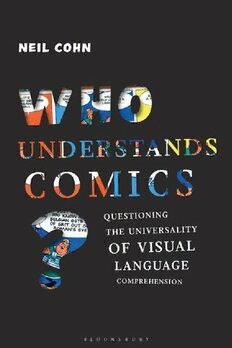
Who Understands Comics?: Questioning the Universality of Visual Language Comprehension PDF
257 Pages·2021·2.565 MB·
Most books are stored in the elastic cloud where traffic is expensive. For this reason, we have a limit on daily download.
Preview Who Understands Comics?: Questioning the Universality of Visual Language Comprehension
Description:
Drawings and sequential images are so pervasive in contemporary society that we may take their understanding for granted. But how transparent are they really and how universally are they understood?Combining recent advances from linguistics, cognitive science and clinical psychology, this book argues that visual narratives involve much greater complexity and require a lot more decoding than widely thought. Although increasingly used beyond the sphere of entertainment as materials in humanitarian, educational, and experimental contexts, Neil Cohn demonstrates that their universal comprehension cannot be assumed. Instead, understanding a visual language requires a fluency that is contingent on exposure and practice with a graphic system. Bringing together a rich but scattered literature on how people comprehend, and learn to comprehend, a sequence of images, this book coalesces research from a diverse range of fields into a broader interdisciplinary view of visual narrative to ask: Who Understands Comics?Visual narratives like comics are so prevalent in contemporary society that most assume they are universal and transparent to understand. Yet, recent cognitive research contradicts this belief, and the complexity of comprehending visual narratives is reinforced by a wide body of literature scattered across decades of research in anthropology, linguistics, and developmental and clinical psychology. This book synthesizes these observations to ask: Who understands comics?This integration of hundreds of scientific studies reaches a provocative conclusion: Sequences of images are comprehended like language, and require a fluency that is contingent on exposure and practice. Filled with extensive reviews of research, this book details how visual narratives engage similar brain mechanisms as language, and reveals diverse cross-cultural patterns from analyses of hundreds of comics from around the world. It surveys how visual narratives are understood and produced by people with little exposure to comics, by children, and by neurodiverse individuals with autism, schizophrenia, and developmental language disorder. Finally, it explores the connections between the comprehension of film and comics, and questions the consequences of this visual language fluency for using comics in educational, humanitarian, and scientific contexts. Altogether, this work shatters assumptions about the simplicity and transparency of visual narratives like comics, while challenging beliefs about the dissimilarity between language and pictures in the mind and brain.
See more
The list of books you might like
Most books are stored in the elastic cloud where traffic is expensive. For this reason, we have a limit on daily download.
